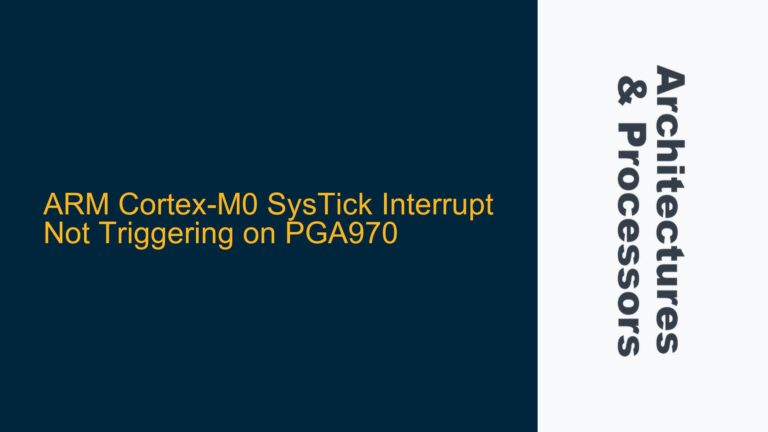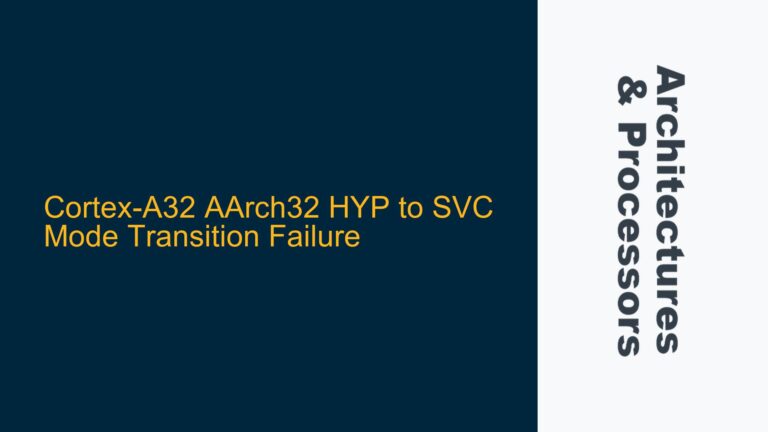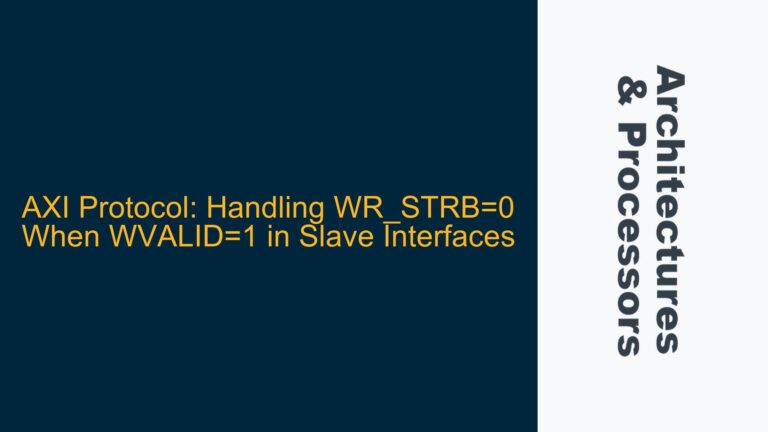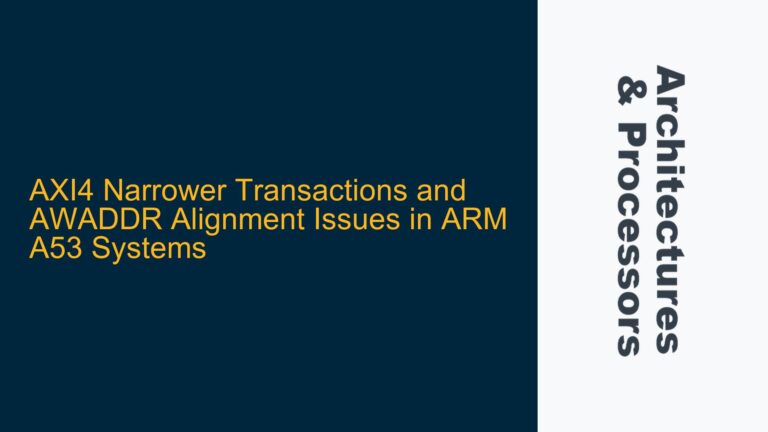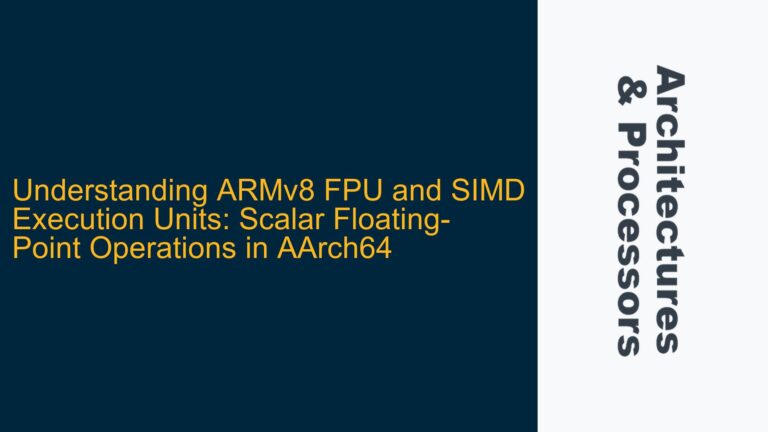GIC Interrupt Configuration Mismatch Between IP and GIC Registers
The core issue revolves around the configuration of the ARM Generic Interrupt Controller (GIC) to handle interrupts generated by an Intellectual Property (IP) block. Specifically, the IP generates edge-triggered interrupts, but there is a question of whether the GIC can be programmed to handle these interrupts as level-triggered, and vice versa. This mismatch between the interrupt type generated by the IP and the configuration of the GIC can lead to significant issues in interrupt handling, including missed interrupts or improper interrupt signaling.
The GIC is a critical component in ARM-based systems, responsible for managing and prioritizing interrupts from various peripherals and IP blocks. It supports both edge-triggered and level-triggered interrupts, but the configuration must match the behavior of the interrupt source. Edge-triggered interrupts are signaled by a transition (either rising or falling edge) on the interrupt line, while level-triggered interrupts are signaled by maintaining a specific voltage level (high or low) on the interrupt line.
The GIC configuration registers, such as GICD_ICFGR
Misconfiguration of GICD_ICFGR Registers and Interrupt Semantics
The primary cause of the issue lies in the misconfiguration of the GICD_ICFGR registers, which define the interrupt semantics (edge-triggered or level-triggered) for each interrupt source. The GICD_ICFGR
For example, if an IP generates level-triggered interrupts, but the GIC is configured to handle them as edge-triggered, the GIC may miss the interrupt if the level is not maintained long enough for the GIC to detect the edge. Conversely, if an IP generates edge-triggered interrupts, but the GIC is configured to handle them as level-triggered, the GIC may incorrectly interpret the edge as a level, leading to improper interrupt handling.
Another potential cause is the misunderstanding of the interrupt semantics between the IP and the GIC. The IP and the GIC must agree on the interrupt type to ensure proper signaling and handling. If the IP is designed to generate edge-triggered interrupts, but the GIC is configured to expect level-triggered interrupts, the system may experience issues such as missed interrupts or improper interrupt state transitions.
Additionally, the use of Message Signaled Interrupts (MSIs) via an Interrupt Translation Service (ITS) introduces another layer of complexity. MSIs are always edge-triggered in the context of the GIC, and if the IP generates level-triggered interrupts, the GIC may not handle them correctly when using MSIs.
Proper Configuration of GIC Registers and Interrupt Handling Mechanisms
To resolve the issue, it is essential to ensure that the GIC is configured correctly to match the interrupt type generated by the IP. This involves setting the appropriate bits in the GICD_ICFGR
-
Identify the Interrupt Type Generated by the IP: The first step is to determine whether the IP generates edge-triggered or level-triggered interrupts. This information is typically available in the IP’s documentation or datasheet. It is crucial to understand the interrupt semantics of the IP to configure the GIC correctly.
-
Configure the GICD_ICFGR Registers: Once the interrupt type is known, the GICD_ICFGR
or GICD_ICFGR E registers must be configured to match the interrupt type. For edge-triggered interrupts, the appropriate bit in the register should be set to indicate edge-triggered semantics. For level-triggered interrupts, the bit should be set to indicate level-triggered semantics. -
Ensure Proper Interrupt Handling in Software: The software that handles the interrupts must also be aware of the interrupt type. For level-triggered interrupts, the software must ensure that the interrupt signal is deasserted by the IP before the interrupt is considered handled. For edge-triggered interrupts, the software must handle the interrupt quickly to avoid missing subsequent edges.
-
Use Memory Barriers and Synchronization Mechanisms: When configuring the GIC registers, it is essential to use memory barriers to ensure that the configuration changes take effect before the interrupts are enabled. This prevents race conditions where the GIC may handle interrupts before the configuration is complete.
-
Test and Validate the Interrupt Handling: After configuring the GIC and implementing the interrupt handling software, it is crucial to test the system to ensure that interrupts are handled correctly. This involves generating interrupts from the IP and verifying that the GIC and software handle them as expected. Any missed interrupts or improper handling should be investigated and corrected.
-
Consider the Use of MSIs and ITS: If the system uses MSIs via an ITS, it is important to understand that MSIs are always edge-triggered in the context of the GIC. If the IP generates level-triggered interrupts, additional logic may be required to convert the level-triggered interrupts to edge-triggered interrupts before they are sent to the GIC.
By following these steps, the system can be configured to handle interrupts correctly, avoiding issues such as missed interrupts or improper interrupt state transitions. Proper configuration of the GIC and understanding of the interrupt semantics are critical to ensuring reliable interrupt handling in ARM-based systems.
Detailed Example: Handling Level-Triggered Interrupts with the GIC
To illustrate the importance of proper configuration, consider a scenario where an IP generates level-triggered interrupts, but the GIC is mistakenly configured to handle them as edge-triggered. In this case, the GIC may miss the interrupt if the level is not maintained long enough for the GIC to detect the edge. This can lead to missed interrupts and improper system behavior.
To avoid this issue, the GICD_ICFGR
-
Determine the Interrupt Type: The IP documentation indicates that the interrupt is level-triggered. The interrupt signal is asserted (high) when the interrupt condition is met and remains high until the condition is cleared.
-
Configure the GICD_ICFGR Register: The GICD_ICFGR
register is configured to indicate level-triggered semantics. This involves setting the appropriate bit in the register to indicate level-triggered interrupts. -
Implement Interrupt Handling in Software: The interrupt handling software is implemented to ensure that the interrupt signal is deasserted by the IP before the interrupt is considered handled. This involves writing to the IP’s control registers to clear the interrupt condition, which deasserts the interrupt signal.
-
Use Memory Barriers: Memory barriers are used to ensure that the GICD_ICFGR
register configuration takes effect before the interrupts are enabled. This prevents the GIC from handling interrupts before the configuration is complete. -
Test and Validate: The system is tested by generating level-triggered interrupts from the IP and verifying that the GIC and software handle them correctly. Any missed interrupts or improper handling are investigated and corrected.
By following these steps, the system can be configured to handle level-triggered interrupts correctly, avoiding issues such as missed interrupts or improper interrupt state transitions.
Detailed Example: Handling Edge-Triggered Interrupts with the GIC
In another scenario, consider an IP that generates edge-triggered interrupts, but the GIC is mistakenly configured to handle them as level-triggered. In this case, the GIC may incorrectly interpret the edge as a level, leading to improper interrupt handling. This can result in the GIC treating a single edge as a continuous level, causing the interrupt to be handled multiple times or not at all.
To avoid this issue, the GICD_ICFGR
-
Determine the Interrupt Type: The IP documentation indicates that the interrupt is edge-triggered. The interrupt signal is asserted (high) for a short duration when the interrupt condition is met, and then deasserted (low).
-
Configure the GICD_ICFGR Register: The GICD_ICFGR
register is configured to indicate edge-triggered semantics. This involves setting the appropriate bit in the register to indicate edge-triggered interrupts. -
Implement Interrupt Handling in Software: The interrupt handling software is implemented to handle the interrupt quickly to avoid missing subsequent edges. This involves reading the IP’s status registers to determine the cause of the interrupt and taking appropriate action.
-
Use Memory Barriers: Memory barriers are used to ensure that the GICD_ICFGR
register configuration takes effect before the interrupts are enabled. This prevents the GIC from handling interrupts before the configuration is complete. -
Test and Validate: The system is tested by generating edge-triggered interrupts from the IP and verifying that the GIC and software handle them correctly. Any missed interrupts or improper handling are investigated and corrected.
By following these steps, the system can be configured to handle edge-triggered interrupts correctly, avoiding issues such as missed interrupts or improper interrupt state transitions.
Conclusion
Proper configuration of the GIC to match the interrupt type generated by the IP is critical to ensuring reliable interrupt handling in ARM-based systems. Misconfiguration of the GICD_ICFGR registers can lead to issues such as missed interrupts or improper interrupt state transitions. By understanding the interrupt semantics of the IP and configuring the GIC accordingly, these issues can be avoided. Additionally, proper interrupt handling in software and the use of memory barriers are essential to ensuring that the system operates as expected. Testing and validation are also crucial to verifying that the system handles interrupts correctly. By following these best practices, developers can ensure reliable and efficient interrupt handling in their ARM-based systems.

